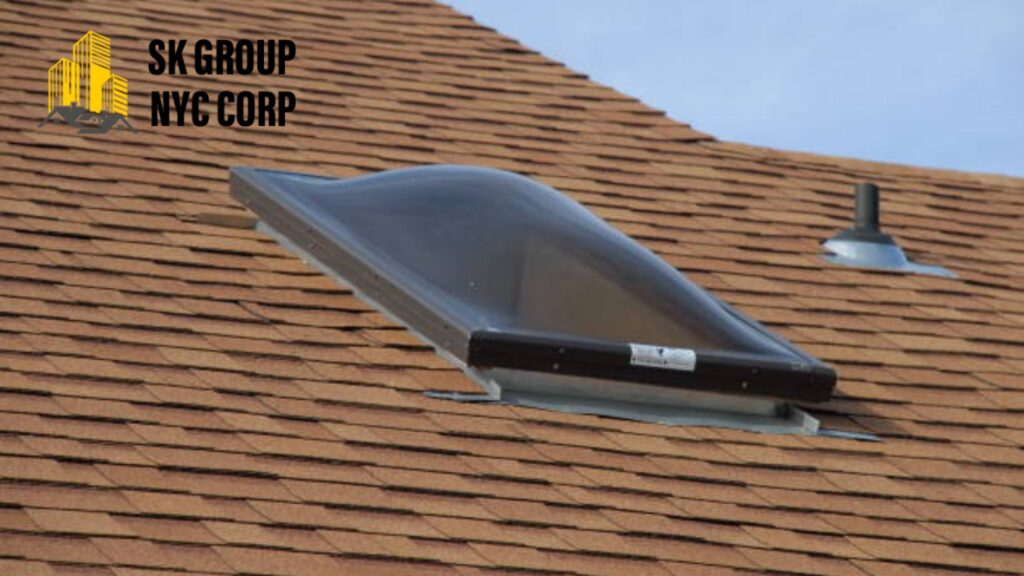When it comes to a strong and energy-efficient roof, roof ventilation installation plays a major role even though many homeowners overlook it. Proper ventilation keeps your home cooler, reduces energy bills, and helps your roof last longer.
At SK Group NYC Corp, we specialize in professional roof ventilation installation across NYC. Here’s everything you need to know about how it works, why it matters, and how it protects your home.
Table of Contents
What Is Roof Ventilation Installation?
Roof ventilation installation is the process of setting up intake and exhaust vents to create a steady flow of air through your attic. These vents regulate temperature and moisture, helping your home breathe naturally.
- Intake vents (usually placed in soffits) pull cool air inside.
- Exhaust vents (like ridge or gable vents) release hot air.
This constant airflow keeps your attic balanced cool in summer and dry in winter.
How Roof Ventilation Installation Works
Hot air rises, and cooler air replaces it that’s the simple science behind good ventilation. During installation, our experts ensure:
- Proper vent placement for maximum airflow.
- Balanced intake and exhaust systems to prevent pressure build-up.
- Sealed gaps and obstructions are cleared for smoother air circulation.
This setup allows your attic to stay close to outdoor temperature levels, preventing heat and moisture from damaging your roof.
Benefits of Roof Ventilation Installation
1. Lower Energy Bills
Without ventilation, hot air gets trapped inside your attic, forcing your AC to work overtime. Proper ventilation installation reduces heat buildup, saving you money on cooling costs.
2. Extends Roof Life
Heat and trapped moisture can weaken shingles, cause cracking, and shorten your roof’s life. With professional installation, your roof stays strong and lasts longer.
3. Prevents Mold and Mildew
A damp attic is the perfect place for mold. Ventilation removes moist air, protecting your wood structure and insulation from damage.
4. Increases Home Comfort
No one likes uneven indoor temperatures. Ventilation balances airflow, keeping your home cooler in summer and warmer in winter.
5. Prevents Ice Dams
In cold months, ventilation helps stop ice dams those heavy ridges of ice that form on your roof edges and cause leaks.
Signs You Need Roof Ventilation Installation
- Your attic feels too hot in summer.
- You see moisture or frost inside during winter.
- There’s mold or mildew growing on wood or insulation.
- Your roof shingles look warped, cracked, or aged too soon.
If any of these sound familiar, it’s time for a professional inspection.
How to Improve Roof Ventilation
1. Inspect Existing Vents
Make sure your current vents aren’t blocked by debris or insulation. Even a small blockage can affect airflow.
2. Add or Upgrade Vents
If your attic isn’t getting enough ventilation, installing additional intake or exhaust vents can fix the issue.
3. Combine Insulation and Ventilation
Insulation prevents heat transfer between your attic and living areas and works best when paired with good ventilation.
4. Hire a Professional Installer
DIY might sound tempting, but improper ventilation can cause long-term roof problems. A certified expert ensures proper sizing, placement, and balance for your home.
Why Choose SK Group NYC Corp for Roof Ventilation Installation?
At SK Group NYC Corp, we don’t just install vents we design smart ventilation systems that fit your home’s structure and climate.
Here’s what makes us different:
- Experienced roofing specialists in NYC roof ventilation installation
- Energy-efficient vent placement for balanced airflow
- Use of premium materials and modern installation methods
- Affordable pricing with long-term savings
- Fast, clean, and reliable service
We help you get the most out of your roof saving energy, money, and time
Final Thoughts
A properly installed ventilation system is one of the best investments you can make for your home. It protects your roof, improves comfort, and boosts efficiency.
If you’re searching for professional roof ventilation installation near you, SK Group NYC Corp is ready to help.
📞 Call us today to schedule your free inspection and keep your roof strong, cool, and efficient all year round!
Have Questions? Call Us Now!
+1 (718) 507-7000
We’re here to help quick answers, friendly service, anytime you need!
Contact SK Group NYC
🌐 Website: www.skgroupnyccorp.com
📍 Serving: Manhattan, Brooklyn, Queens, The Bronx, and Staten Island
📍 Address: 87-88 172nd St, Jamaica, New York, NY, United States, New York

